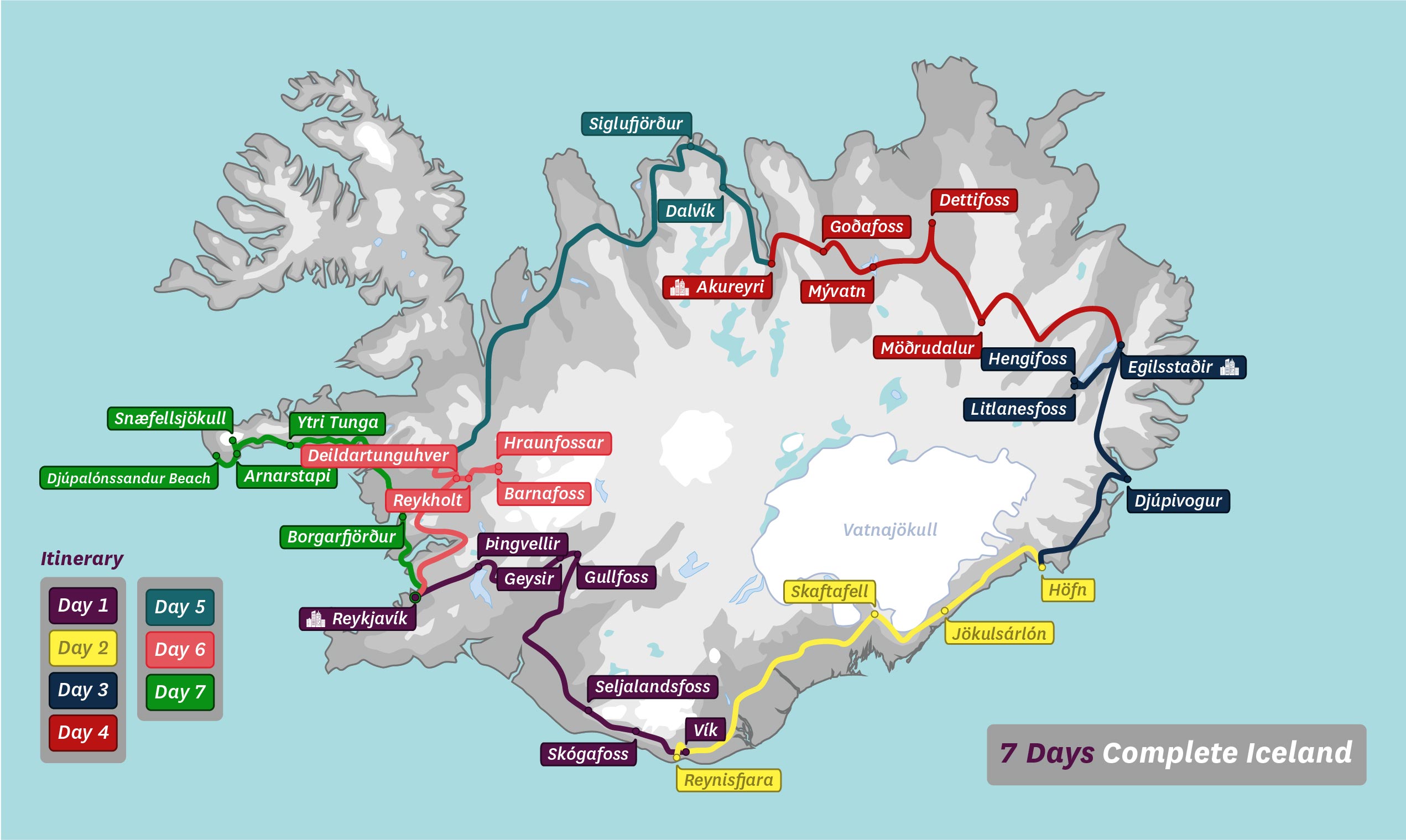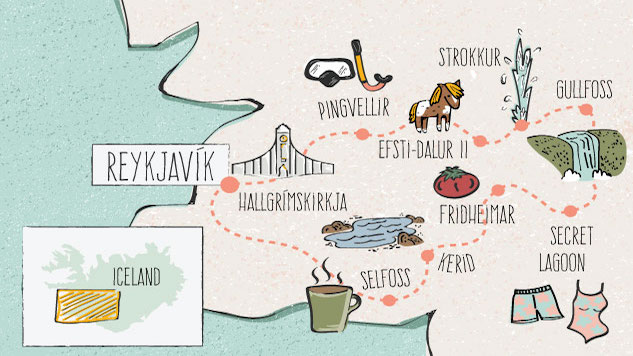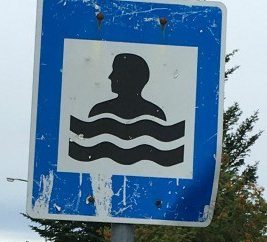Iceland has always been on the top of my bucket list. And I’ll admit that planning this Iceland road trip was not an easy task.
So, I hope to share with you some pointers to help you prepare for your Iceland Ring road trip.
This post will only discuss about the Ring road trip.
Should I do the Ring road, or not ?
This should be your first question to answer. Iceland is a magical place, and most of its beauty is out of this world because it has been well kept and preserved, untouched by human development. Which means most of the beautiful imageries you seen before, are away from the city centre, Reykjavik.
Hence, the best way to truly experience Iceland’s beauty is to drive around the whole island. The Ring road is paved road, and designed perfectly for road trips. A round trip would take minimum 7 days, but most people will advise to take a comfortable pacing of 8 to 10 days.

The Ring road trip shouldn’t be taken lightly. Expect to drive at least 2 to 3 hours a day. Also, the further away you are from Reykjavik, the less hotels there are. From my experience, anywhere beyond Vik, you can only find a handful of guesthouses or hostels. The only accommodation option is camping, whether it is inside a camper van or in a tent. Food options are also limited and crazy expensive. Expect to cook on your own.
So, before you hastily answer the first question, consider whether you are prepared for the above; or if you are travelling with younger children, can you manage all these inconveniences ?
If you choose not to do the Ring road, the other option is to base yourself in Reykjavik, and join a day touring group. With this option, you get the comfort of hotel stays, and plenty of food options, while still not missing too much of the Icelandic sights. The popular tour program is the Golden circle, which includes a few popular waterfalls, Pingvellir national park, Icelandic horses, geysir, and maybe geothermal bath.

When to go
It depends. There are two timings to visit Iceland, i.e.
- When it is dark most of the time, to see the Northern lights
- When it is bright most of the time (midnight sun), to see everything else not covered in snow
To see the Northern lights, the sky must be pitch black. Hence, the best time to visit Iceland if you plan to catch the aurora is February to March. However, everything will be covered in snow, if not ice. And driving during winter can be dangerous.
The more comfortable time to visit Iceland is during summer, which is also peak season for tourists (June to August). Temperature is comfortable, and rainfall is lowest. And most importantly, the light is superb, as you get daylight 18 to 20 hours a day. You’ll also get one long perpetual sunset from 9pm to midnight, which is golden “hours” for all photographers!
If you want to avoid the crowd, travel in September.
Car or Camper van ?
Next question is whether you should rent a car or camper van.
Renting a car saves you on car rental and petrol cost, but unless you are ready to sleep inside a tent, you need to spend more on accommodation (which won’t be cheap as you travel farther away from Reykjavik). Renting a car would cost from 60 EUR a day for a hatchback.
Renting a camper van will cost about 140 EUR a day. However, if you book nearer to your travel date, you may be able to get a discount. In our case, we got pretty good deal, and paid only 460 EUR for 4 days (about 115 EUR a day), and even got an upgrade later upon arrival (from Ford Kangoo to Ford Traffic).

Most car rental companies provide pick up and drop off arrangements at KEF airport for a fee. The extra fee is worth considering, as airport transfer service / taxi can be very expensive.
Tip: It is highly recommended to get insurance with your car rental. At the minimum for windscreen coverage, and gravel damage protection. You’ll likely get some basic insurance (e.g. collision damage) with the car rental, but weather can be unpredictable in Iceland, and the winds are strong ! We got a supplemental insurance with Rentalcover.com and paid 30 EUR for additional 2,500 EUR coverage.
2WD or 4×4 ?
There are generally 2 types of road in Iceland.
First is the paved Ring roads which connects all the major towns. These are easy and safe to drive on. Second is the F-roads, which are unpaved, gravel, and sometimes with river crossings.
2WD is generally adequate if you plan to just stay on the Ring roads. There may be sections along the Ring road where you need to drive on short distance of gravel access roads, but these are fairly flat. It is illegal for 2WD to drive on F-roads.
4WD is highly recommended if you are travelling in winter as ice quickly forms even on the paved Ring roads. 4×4 also allows you to drive on F-roads, and it does lead you to many off the beaten gems. We didn’t get a 4×4 during my last trip, but will definitely consider it the next time we return to Iceland. Check out this very informative guide on F-road driving for your planning.
Where to stay ?
Accommodations consideration will depends on whether you are renting a car or camper van.
If you are renting a car, your options are,
- Sleep inside a tent, of which you will need to park you car at the many camp sites available along the Ring road
- Check in a guesthouse or Airbnb, and make sure you pre book all your accommodations at least two months ahead (as they are very limited)
If you are renting a camper van, your only option is to park at camping site.
Parking fee for camping site cost about 25 EUR a night, and includes basic kitchen facilities and toilets (most shower facilities require additional cost, about 4 EUR per 5 minutes).
Airbnb (though limited) can cost from 60 EUR a night, and guesthouses from 90 EUR a night. As such, the renting car option would cost on average 120 to 150 EUR a day.
In short, the renting car option may seem cheaper, but if you are not ready to sleep inside a tent out in the cold, be sure to pre book all your accommodations way ahead. We made this mistake and in the end couldn’t find any accommodation. And since I wasn’t going to sleep inside a tent, we had to go with the camper van option. Although, in the end it worked out for us, given we got a good deal with the lender, and an upgrade !
Tip: We booked our camper van through Northbound, whom offered the last minute discount. Note that Northbound is only acting as a middle person. We had to do most of our dealings with the lender (Nordic campers, in our case).
What to bring ?
Besides the basic essentials you usually bring along your travel (like clothes, toiletries etc), below are some items I find useful for your Ring road trip,
- Smartphone with internet data – you’ll be using a lot of Google maps, and it is always essential to check out road conditions or road blocks (www.road.is) , and weather forecast (http://vedrid.is) before you start driving
- Extra power for smartphone – the last thing you want is your smartphone battery to die on you in the middle of nowhere – be sure to bring at least a loaded power bank, or car power adapter (to keep your smartphone charging while driving)
- Sleeping bag – or at least check with your car lender if they provide sleeping bag (usually at a charge), we didn’t bring our own so we ended up paying 25 EUR per sleeping bag for rent – at that price, we could have bought it !
- Appropriate clothing and layers – even if you are planning to travel in summer, Iceland wind can be very strong, and if it drizzles, it can be very cold – make sure you bring enough layers to keep you dry and warm
- Water bottle – bottled water in Iceland is very expensive – since all tap water in Iceland is safe for drinking, you should carry a reusable water bottle and refill for free any gas station
What to eat
Eating out in Iceland, especially outside of Reykjavik, is crazy expensive. A bowl of minestrone soup costs about 15 EUR, fish and chips 25 EUR etc.
If you want to save of food, your options are,
- Pack with you instant food – my friend just brought 30 kg of instant food (for 2 pax) from Malaysia on his Ring road trip !
- Buy basic ingredients from local groceries (e.g. Bonus or Kronan) and cook yourself in the kitchen facilities at camp sites. Groceries are not as expensive as we expected it to be. Just be sure to avoid convenience stores at gas stations.

Where to shower
If you are renting a car or camper van like us, you can either take your shower at the shower facilities available at the camping sites, usually at extra cost, about 500 Krona (about 4 EUR) for 5 minutes of water ! Or, you can do like us, i.e. check out the local swimming pools !
Every town no matter how small has a local swimming pool, with warm water heated by geothermal energy. And it is usually within walking distance from the bigger camping sites.

Tip: Look out for the sign. We had no idea at first that the sign means swimming pool, we thought it is some danger sign for drowning hazards !
The entrance fee costs a bit more, about 6 to 8 EUR per person. However, I rather pay the extra for a good hot bath (similar to onsen in Japan), followed by good proper shower without having to rush myself to finish off in 5 minutes !
For more information on swimming pools in Iceland, check out this other post !

Very comprehensive guide. I was going to do a ten day round the island trip but instead cut it to five and stayed on the south coast. Didn’t fancy a tent either.
LikeLiked by 1 person
Yea, we totally didn’t regret our decision to half our road trip. Like this, we get to plan another one to catch Aurora ! =)
LikeLiked by 1 person
I’m the same. We went in September which was too early, but saw some amazing outdoor things. The Aurora is a great reason to go back.
LikeLiked by 1 person
Wait, your friend actually brought 30 kg-weighed instant food from Malaysia for the trip? Now I wonder whether it’s the picture of boiling Maggi over there. *lol*
Thanks for sharing! 🙂
LikeLiked by 1 person
It is Korean instant noodles ! Hehe =p
LikeLike
This is really useful information for planning a trip to Iceland. I haven’t been to Iceland yet but this has definitely added handy tips to be kept in mind. I think trip #1 I will do the Golden Circle and trip #2 venture further with a camper van! The maps are super helpful and I love your bright yellow camper!
LikeLiked by 1 person
I’m glad this is useful to u ! Enjoy Iceland !! =)
LikeLike
Iceland is very high on my wish list especially because it’s rapidly getting commercialized. Being a road trip enthusiast, I love your post. It looks like an awesome self drive road trip offering best of Iceland. My preferred timing would be in summer. Thanks for this inspiring post with all useful and essential travel tips.
LikeLiked by 1 person
Great value post, Jeremy! I would definitely go with camper van.. ✨👌💚
LikeLiked by 1 person
Good choice ! I’m sure you’ll have an amazing experience !!
LikeLike
A very interesting read, Iceland is high on my list of places to visit. I’d never considered a camper van as I thought it would be too cold but you proved it is doable. I knew Iceland was expensive but your example of the price of meals was a real eye opener. It doesn’t put me off going it just means I’ll be prepared!
LikeLiked by 1 person
Make sure your camper van comes with space heater. And bring extra sleeping bag to use as blanket ! =)
LikeLiked by 1 person
Your camper is so cute! Also, props to your friend for bringing 30kg of instant food hahahaa. I did the Ring Road road trip with my dad in September and it felt like we didn’t pack enough instant noodles. (Let’s be honest, no one is paying 15 euros only for a plate of fries.) These are superb tips for first timers and I kinda wish I’d known some before my trip!
LikeLiked by 1 person
What a great guide! I’ve been to Iceland once and want to go again a do a more camping road trip style adventure like you did. So great to know the prices and how to deal with showering, stuff I did not even think of!
LikeLiked by 1 person
It is such a beautiful country ! I definitely want to return again ! In winter and hopefully I can see aurora !!
LikeLike
Iceland has always been on our bucket list and we have been dreaming about it for some time and hope to get there soon. We have read a lot about the Ring Road Trip and are fascinated by it. But your post provides some really basic and practical information for planning the Ring Road trip, which will be invaluable for first-time visitors like us.
LikeLiked by 1 person
Hope u check this beautiful country off your bucket list soon 😊
LikeLike
is it cold in camper van on the month of november,or should we just stay in motels or cottages
LikeLike